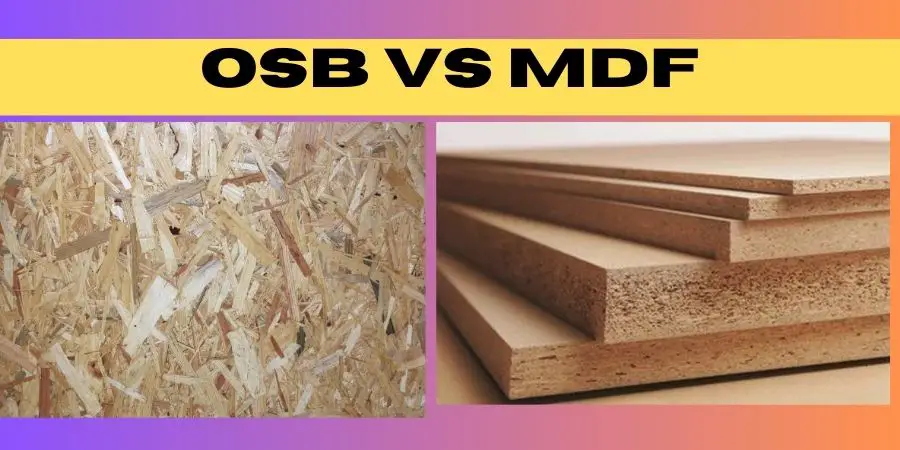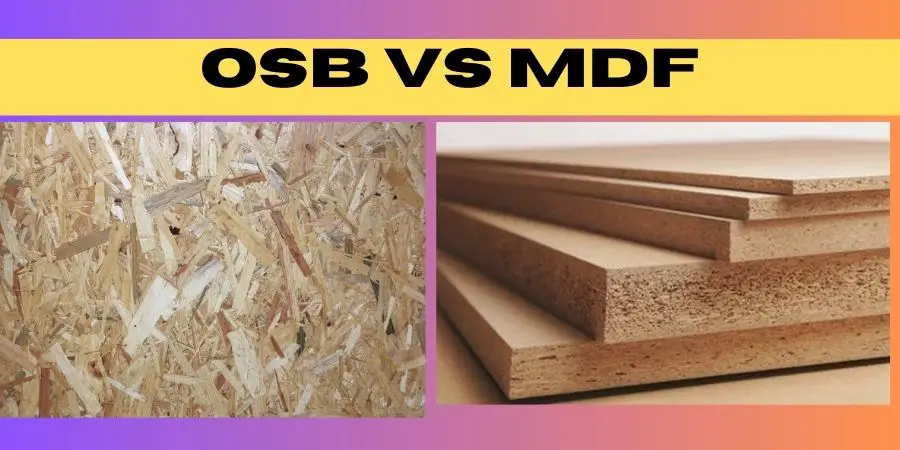MDF (medium-density fiberboard) and OSB (oriented strand board) are both types of engineered wood made from wood fibers and adhesive. However, they have different properties and uses, so let’s take a closer look at each.

The major difference between MDF and OSB is the way they are made and their characteristics. MDF is made by compressing wood fibers together using heat and pressure, resulting in a smooth and uniform surface that is easy to paint or veneer. OSB is made by compressing wood strands together using adhesives, resulting in a rough and uneven surface that is strong and durable. MDF is commonly used for furniture, cabinetry, and decorative trim, while OSB is commonly used for construction and DIY projects, such as sheathing, subflooring, and roofing.
MDF: Smooth and Versatile
MDF is made from wood fibers that are glued together and compressed to form a dense, smooth board.
It’s often used for furniture, cabinetry, and decorative trim because it can be painted or veneered to look like natural wood, and it has a uniform surface that’s easy to work with. MDF is also a popular choice for interior doors because it’s stable and resists warping.
One drawback of MDF is that it’s not as strong as some other types of wood, so it may not hold up well under heavy loads or in high-traffic areas. It also has low moisture resistance, so it’s not suitable for outdoor use or in areas where it may get wet.
OSB: Strong and Affordable
OSB is made from thin wood strands that are layered and oriented in different directions, then glued and compressed to form a sturdy board.
It’s often used for sheathing and subflooring in construction because it’s strong and affordable.
It’s also a good choice for DIY projects that require a strong, flat surface, like shelves or workbenches.
One advantage of OSB is that it’s more moisture-resistant than MDF, so it can be used in damp or humid areas like basements or bathrooms.
However, OSB can be rough and uneven, which makes it less suitable for decorative uses.
MDF vs OSB: Which is Better?
The answer to this question depends on what you’re using the wood for.
If you need a smooth, paintable surface for furniture or decorative trim, MDF is the way to go. If you need a strong, affordable board for construction or DIY projects, OSB is a better choice.
However, keep in mind that both MDF and OSB have their limitations.
They’re not as strong or durable as natural wood, and they may not hold up well under certain conditions.
So, it’s always a good idea to consult with a professional or do your research before choosing a type of engineered wood for your project.
Here are some pros and cons of MDF and OSB:
MDF Pros:
- Smooth and uniform surface that is easy to paint or veneer to look like natural wood
- Stable and resists warping, making it a good choice for interior doors
- Versatile and can be used for a variety of applications, including furniture, cabinetry, and decorative trim
MDF Cons:
- Not as strong as some other types of wood and may not hold up well under heavy loads or in high-traffic areas
- Low moisture resistance and not suitable for outdoor use or in areas where it may get wet
- Contains formaldehyde and other chemicals, which can be harmful to human health if not handled properly
OSB Pros:
- Strong and durable, making it a good choice for construction and DIY projects
- Affordable and widely available
- More moisture-resistant than MDF, making it suitable for use in damp or humid areas
OSB Cons:
- Rough and uneven surface, which makes it less suitable for decorative uses
- Prone to swelling and warping if exposed to moisture for prolonged periods of time
- Less stable than MDF and may expand or contract in response to changes in temperature or humidity
What are the differences?
Sure, here are some differences between MDF and OSB:
- Composition: MDF is made from wood fibers that are glued together and compressed, while OSB is made from thin wood strands that are layered and oriented in different directions, then glued and compressed.
- Surface: MDF has a smooth and uniform surface that’s easy to work with, while OSB can be rough and uneven.
- Strength: OSB is generally stronger than MDF and can withstand heavier loads and more wear and tear.
- Moisture resistance: OSB is more moisture-resistant than MDF, which makes it suitable for use in damp or humid areas.
- Uses: MDF is often used for furniture, cabinetry, and decorative trim, while OSB is commonly used for sheathing and subflooring in construction.
- Appearance: MDF can be painted or veneered to look like natural wood, while OSB is not typically used for decorative purposes due to its rough surface.
MDF vs OSB uses
MDF uses.
- Furniture: MDF is commonly used for furniture because of its smooth surface, stability, and versatility. It can be cut and shaped into various designs and can be painted or veneered to look like natural wood.
- Cabinetry: MDF is a popular choice for cabinets because it is easy to work with and has a consistent texture that makes it suitable for painting or finishing.
- Decorative trim: MDF is often used for decorative trim, such as baseboards, crown molding, and wainscoting. It can be shaped into intricate designs and painted to match any decor.
- Interior doors: MDF is a good choice for interior doors because it resists warping and has a smooth surface that can be painted or stained.
OSB uses.
- Construction: OSB is commonly used for sheathing and subflooring in construction because of its strength and durability. It can withstand heavy loads and is resistant to moisture and pests.
- DIY projects: OSB is a popular choice for DIY projects, such as building shelves, workbenches, and storage units. It is affordable and easy to work with.
- Roofing: OSB can be used as a roof decking material in place of plywood. It is strong and durable, and its moisture resistance makes it suitable for use in damp or humid environments.
- Wall panels: OSB can be used as wall panels in commercial or industrial buildings. Its strength and durability make it a good choice for high-traffic areas.





